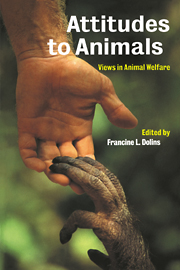Book contents
- Frontmatter
- Contents
- List of contributors
- Acknowledgements
- Part I Attitudes to animals
- Part II Animal awareness
- Part III Animal welfare
- Part IV Research and education
- Part V Epilogue: the future of wild animals
- 16 Human sentiment and the future of wildlife
- 17 In the absence of animals: power and impotence in our dealings with endangered animals
- Index
17 - In the absence of animals: power and impotence in our dealings with endangered animals
Published online by Cambridge University Press: 16 November 2009
- Frontmatter
- Contents
- List of contributors
- Acknowledgements
- Part I Attitudes to animals
- Part II Animal awareness
- Part III Animal welfare
- Part IV Research and education
- Part V Epilogue: the future of wild animals
- 16 Human sentiment and the future of wildlife
- 17 In the absence of animals: power and impotence in our dealings with endangered animals
- Index
Summary
I was not supposed to see what I saw. It had taken me a month of persistence and all the subtleties of deference to get access to these condors, to be in this place at this time. It made me a witness, not to a nicely managed public-relations triumph, but to a secret no one wanted to admit.
AC-3 was dying. We didn't want to admit it. But no amount of wishful thinking could alter what would turn out to be her end. She was the last California condor to die in the wild. She did not precisely die in the wild, but she might as well have. She was the last successfully breeding female condor in the wild, and by the time she was captured, she was nearly dead anyway.
I saw her in the wild just before she was captured, before anyone knew for certain what was wrong with her. I watched her for a full day. She sat across the canyon from me in the top of a pine, behaving strangely.
Her perch was about half a mile from us, across a steep ravine called Bittercreek Gorge, pleated with ridges and alive with the splendid greens of pines and live oaks. On the top of a pine, AC-3 would shake out her wings, immense and black with white triangles in the lining – the classic identification mark for a condor. A huge vulture hunched on a melancholy perch, she betrayed no hints as to what was wrong with her.
- Type
- Chapter
- Information
- Attitudes to AnimalsViews in Animal Welfare, pp. 244 - 257Publisher: Cambridge University PressPrint publication year: 1999
- 1
- Cited by



